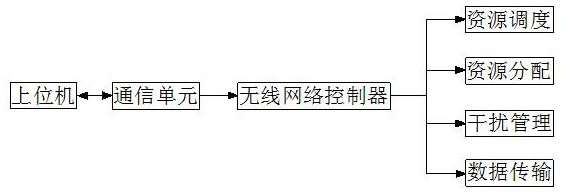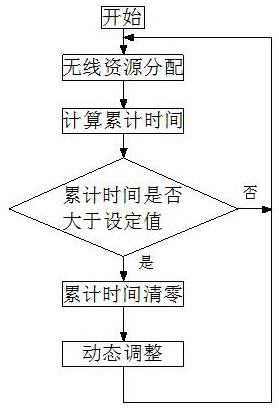Radio resource management device with quick response
A wireless resource management and rapid response technology, applied in network traffic/resource management, wireless communication, digital transmission system, etc., can solve the problem of strong signal interference, affecting normal communication and data security, etc. The impact of interference, the effect of improving resource allocation rate, and improving system performance
- Summary
- Abstract
- Description
- Claims
- Application Information
AI Technical Summary
Problems solved by technology
Method used
Image
Examples
Embodiment 1
[0040] Such as Figure 1-2 As shown, a fast-response wireless resource management device includes a wireless network controller; the wireless network controller is connected to a communication unit, and the communication unit is connected to a host computer, and the wireless network controller includes a resource scheduling module and a resource allocation module , interference management module, data transmission module;
[0041] The resource scheduling module allocates a variable number of channels to each wireless network client, and the number of channels depends on the user rate performance of the wireless network client;
[0042] The resource allocation module includes a wireless resource allocation module and a dynamic adjustment module. The wireless resource allocation module allocates specific user resources on the premise that the number of sub-channels in each virtual network is determined. The dynamic adjustment module dynamically adjusts the sub-channels allocated...
Embodiment 2
[0051] Such as image 3 , 5 As shown, on the basis of Embodiment 1, the resource scheduling module effectively meets the speed requirements of different network users, and adopts the priority in proportional fairness to ensure the fairness of the degree of mobility. In the specific allocation process, each sub-network will Allocate a certain number of sub-channels, and the specific number of sub-channels is dynamically adjusted according to the average rate of the sub-network; the allocation process is as follows: the first step, the system initializes to obtain the number of available sub-channels; the second step, after the first part of resource allocation is executed, the system will Evaluate whether the accumulated time has reached the set time and whether it is greater than the set value. The set value is the update frequency of the adjusted value in the second part; in the third step, if the accumulated time is greater than the set value, the system will check the numbe...
Embodiment 3
[0054] On the basis of Embodiment 2, the method for using resource allocation by the resource scheduling module includes: step a, the regional network node obtains node information, and the node information includes its own parameters and node communication speed; step b, the host computer obtains the node information through the controller; Step c, judge whether you need to allocate network resources according to the power-saving communication rate obtained by the regional nodes. If you need to allocate, continue to perform operations. information, adjust the number of sub-channels in the network, and generate a resource allocation file; step e, dynamically adjust the number of sub-channels in the network area nodes according to the generated resource allocation file.
PUM
 Login to View More
Login to View More Abstract
Description
Claims
Application Information
 Login to View More
Login to View More - R&D
- Intellectual Property
- Life Sciences
- Materials
- Tech Scout
- Unparalleled Data Quality
- Higher Quality Content
- 60% Fewer Hallucinations
Browse by: Latest US Patents, China's latest patents, Technical Efficacy Thesaurus, Application Domain, Technology Topic, Popular Technical Reports.
© 2025 PatSnap. All rights reserved.Legal|Privacy policy|Modern Slavery Act Transparency Statement|Sitemap|About US| Contact US: help@patsnap.com



